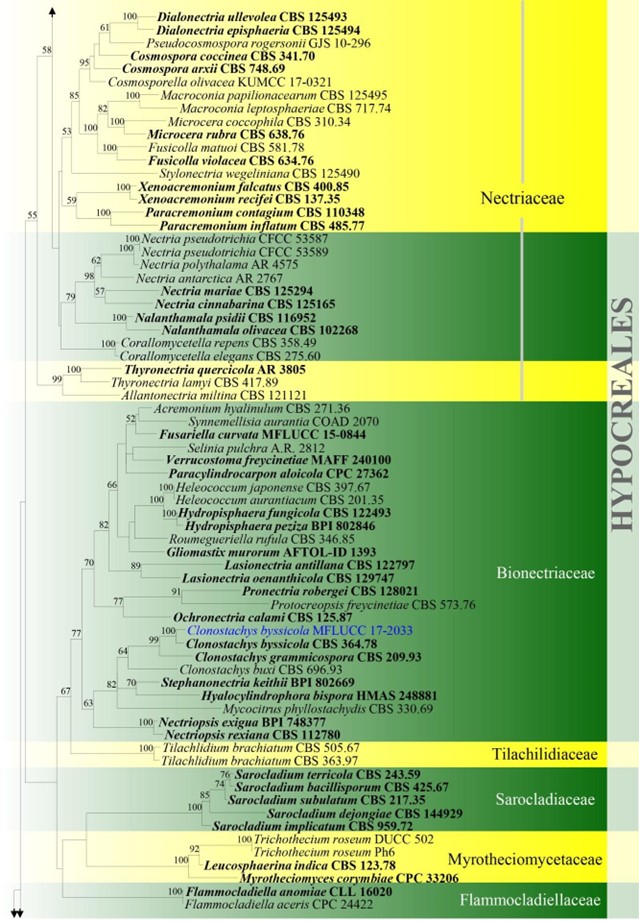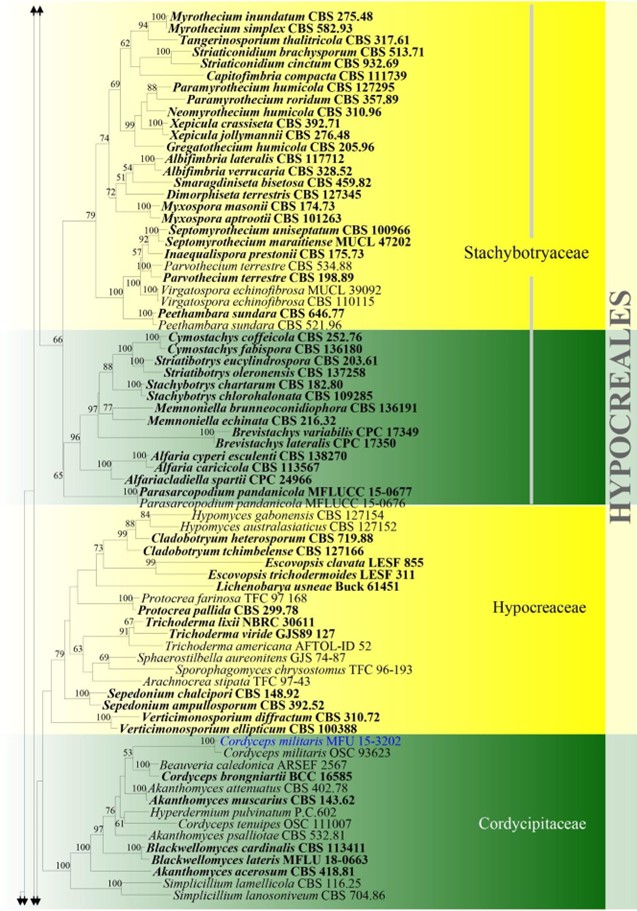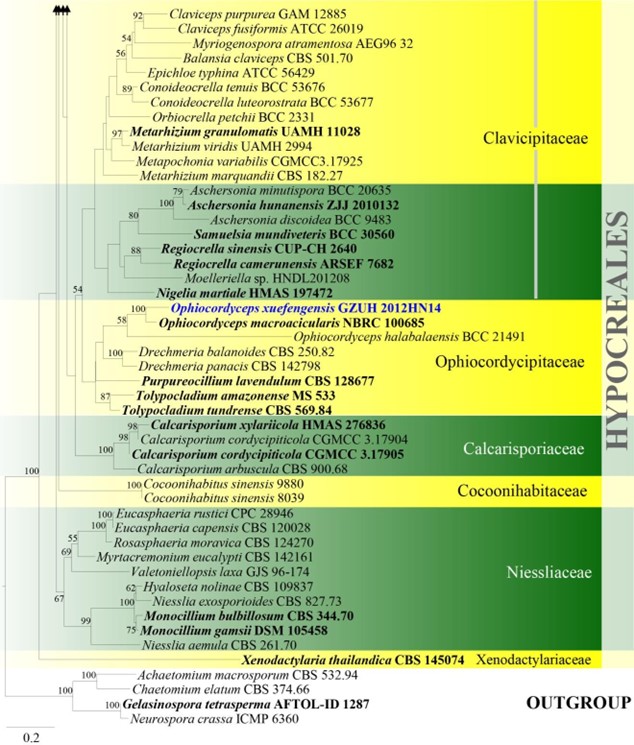Hypocreales Lindau, Nat. Pflanzenfam., Teil. I (Leipzig) 1(1): 343 (1897)
MycoBank number: MB 90477; Index Fungorum number: IF 90477; Facesoffungi number: FoF 02091;
According to Wijayawardene et al. (2018a) Hypocreales comprised nine families. Maharachchikumbura et al. (2016b) listed 223 genera belonging to families of Hypocreales based on the literature and phylogenetic analysis. Later, two new genera were introduced to Bionectriaceae: Bullanockia, and Paracylindrocarpon, based on DNA evidence and morphological data (Crous et al. 2016a, b). Corinectria, Pleiocarpon, Varicosporella and Xenoleptographium were also added in Nectriacae (González & Chaverri 2017, Aiello et al. 2017, Lechat & Fournier 2015, Crous et al. 2015d). Cryptoniesslia was introduced from previous research to Niessliaceae by Scheuer (1993) and Crous et al. (2016b) added Mycophilomyces to Clavicipitaceae.
Blackwellomyces was added to Cordycipitaceae by Kepler et al. (2017). Maharachchikumbura et al. (2016b) listed seven genera in Stachybotryaceae. Lombard et al. (2016) revisited the family and 36 genera were accepted in Stachybotryaceae, including 22 new genera which based on multigene phylogeny and morphological data. Cylindriaceae, Sarocladiaceae and Xenodactylariaceae were added to the order by Crous et al. (2018a, b). However, in our phylogentic anlysis, Cylindriaceae groups within Amphisphaeriales (Xylariomycetidae), sister to Clypeophysalosporaceae and Sporocadaceae (Figs 1, 2). Xenodactylariaceae does not appear to be related to Hypocreales as it forms a separate lineage from the order, and basal to Torpedosporales (Figs 1, 2). Flammocladiellaceae was introduced to accommodate the monotypic genus Flammocladiella by Crous et al. (2015b). It grouped as sister clade to Clavicipitaceae with low statistical support (Crous et al. 2015b), and similar results were obtained by Maharachchikumbura et al. (2016b). Flammocladiellaceae grouped within Clavicipitaceae (Hongsanan et al. 2017, Sun et al. 2017), hence it was not accepted as a family. Hongsanan et al. (2017) treated Flammocladiellaceae under Clavicipitaceae based on phylogenetic data. However, Lechat & Fournier (2018a) observed that Flammocladiellaceae is affiliated to Bionectriaceae. In our phylogenetic analysis, Flammocladiellaceae forms a separate clade distant from Clavicipitaceae with low statistical support (Figs 1, 15). Hence, we maintain Flammocladiellaceae as a separate family in Hypocreales following Crous et al. (2015b). Here we accept 14 families in Hypocreales, namely: Bionectriaceae, Calcarisporiaceae, Clavicipitaceae, Cocoonihabitaceae, Cordycipitaceae, Flammocladiellaceae, Hypocreaceae, Myrotheciomycetaceae, Nectriaceae, Niessliaceae, Ophiocordycipitaceae, Sarocladiaceae, Stachybotryaceae, and Tilachlidiaceae, based on molecular evidence. The divergence time for Hypocreales has been estimated as 229 MYA (Fig. 2). Currently there are 303 genera in this order (this paper).

Figure 1 – Maximum likelihood (ML) majority rule combined LSU, SSU, tef1 and rpb2 consensus tree for the analyzed Sordariomycetes isolates. Families are indicated in yellow and green coloured blocks and orders are indicated in dark and light grey coloured blocks. RAxML bootstrap support values (MLB above 50 %) are given at the nodes. The scale bar represents the expected number of changes per site. The tree is rooted with Botryotinia fuckeliana (AFTOL ID-59), Dothidea sambuci (DAOM 231303), and Pyxidiophora arvernensis (AFTOL-ID 2197).

Figure 1 – Continued.

Figure 1 – Continued.

Figure 2 – The maximum clade credibility (MCC) tree, using the same dataset from Fig. 1. This analysis was performed in BEAST v1.10.2. The crown age of Sordariomycetes was set with Normal distribution, mean = 250, SD = 30, with 97.5% of CI = 308.8 MYA, and crown age of Dothideomycetes with Normal distribution mean = 360, SD = 20, with 97.5% of CI = 399 MYA. The substitution models were selected based on jModeltest2.1.1; GTR+I+G for LSU, rpb2 and SSU, and TrN+I+G for tef1 (the model TrN is not available in BEAUti 1.10.2, thus we used TN93). Lognormal distribution of rates was used during the analyses with uncorrelated relaxed clock model. The Yule process tree prior was used to model the speciation of nodes in the topology with a randomly generated starting tree. The analyses were performed for 100 million generations, with sampling parameters every 10000 generations. The effective sample sizes were checked in Tracer v.1.6 and the acceptable values are higher than 200. The first 20% representing the burn-in phase were discarded and the remaining trees were combined in LogCombiner 1.10.2., summarized data and estimated in TreeAnnotator 1.10.2. Bars correspond to the 95% highest posterior density (HPD) intervals. The scale axis shows divergence times as millions of years ago (MYA).

Figure 2 – Continued.

Figure 2 – Continued.

Figure 15 – Phylogram generated from maximum likelihood analysis based on combined LSU, ITS, cmdA, rpb2, tef1 and tub2 sequence data for Hypocreales. Two hundred sixty six strains are included in the combined analysis which comprised 4731 characters (890 characters for LSU, 906 characters for ITS, 557 characters for cmdA, 862 characters for rpb2, 1163 characters for tef1, 348 characters for tub2) after alignment. Single gene analyses were carried out and the phylogenies were similar in topology and clade stability. The best RaxML tree with a final likelihood value of – 143259.087299 is presented. Estimated base frequencies were as follows: A = 0.238481, C = 0.265503, G = 0.275795, T = 0.220220; substitution rates AC = 1.361350, AG = 3.162200, AT = 1.584547, CG = 1.000927, CT = 7.415164, GT = 1.000000; gamma distribution shape parameter a = 0.592521. Bootstrap support values for ML greater than 50% are given near the nodes. The tree is rooted with Achaetomium macrosporum CBS 532.94, Chaetomium elatum CBS 374.66, Gelasinospora tetrasperma AFTOL-ID 1287, and Neurospora crassa ICMP 6360. Ex-type strains are in bold. The newly generated sequences are indicated in blue.

Figure 15 – Continued.

Figure 15 – Continued.

Figure 15 – Continued.
